
Hearts and Arrows
Formation of the Hearts and Arrows patterns
Intro
Every polisher knows that polishing Hearts and Arrows by HRD Antwerp is not easy. Some knowledge about the
optical formation of both the hearts and the arrows can ease the job. This article reveals the exact
interaction between the facets and the heart and arrows pattern. The polishing sequence of the facets used
in this article is not exclusive. There are other polishing schemes possible to create a Heart and Arrows
brilliant. The sequence demonstrates the exact number of facets needed to form one heart and one arrow.
Pavilion main facets are coded as Pm(index), pavilion halve facets as Ph(index).
Crown main facets are coded as Cm(index) and star facets as Cs(index).Forming the hearts
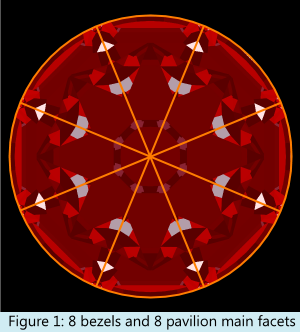 Each heart is formed by several facets. The structured light is entering the diamond and the diamond facets
start to interact with each other creating optical effects. The slightest faceting error in depth, angle or
azimuth can lead to deformed heart patterns. The heart patterns are created mainly by the pavilion main and
half facets.
Let's take a look at the formation of the heart patterns.
First the creation of perfect symmetrical hearts
is explained. In a next article some examples of common polishing errors together with their influence on
the heart pattern are given.
Each heart is formed by several facets. The structured light is entering the diamond and the diamond facets
start to interact with each other creating optical effects. The slightest faceting error in depth, angle or
azimuth can lead to deformed heart patterns. The heart patterns are created mainly by the pavilion main and
half facets.
Let's take a look at the formation of the heart patterns.
First the creation of perfect symmetrical hearts
is explained. In a next article some examples of common polishing errors together with their influence on
the heart pattern are given. A perfectly preprocessed diamond, 8 main crown facets and 8 main pavilion facets, shows no hearts and no arrows (figure 1). A perfect round girdle is assumed. The first pavilion half, Ph1, gives birth to one of the two lobs of the first heart. The result of this first step, when viewed through a H&A viewer, is illustrated in figure 2. On the opposite side the white triangular shaped polygon forms a half of the v-shape of the fourth heart. The formation proceeds with the following pavilion half resulting in Figure 3. The second lob of the first heart is getting shaped. As in step 1, polishing
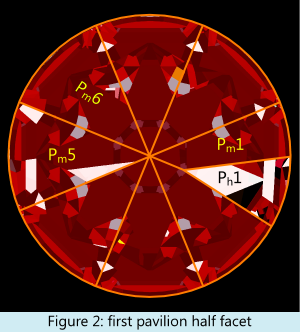
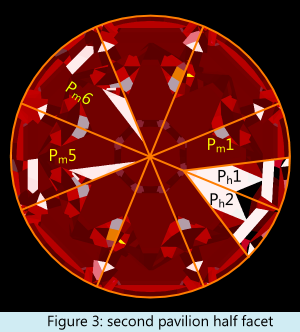
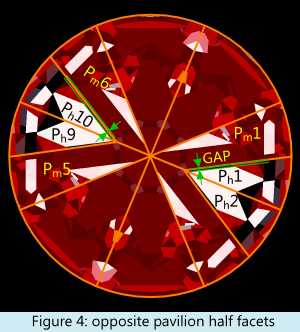
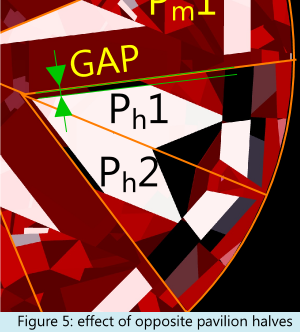
Besides creating the basic shape of the fourth heart they reveal a subtle effect on the shape of the opposite heart. A small gap is created between the hearts and the edge between the halves and the pavilions (Figure 5). The next stage in the process is how to form the v-shape on the first heart. To achieve this proceed with another two halves, Ph8 and Ph11 and investigate how they influence the patterns. At this stage the heart pattern is almost complete (figure 7 and 8). To flatten the shoulders of the heart the star facets are being polished. The result of this action is illustrated in
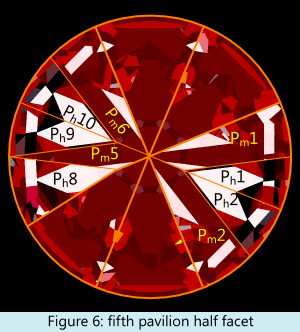
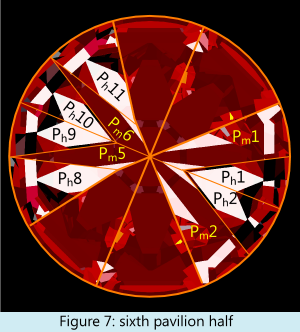
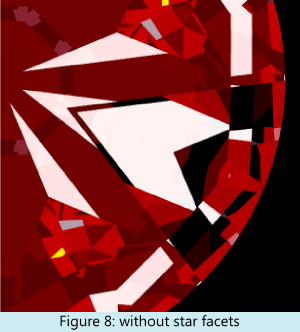
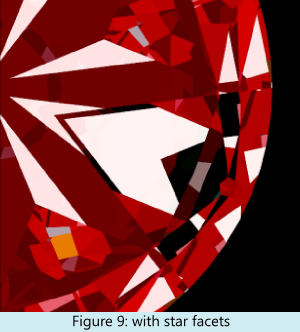
figure 9. It is amazing but it requires TEN pavilion facets and TWO crown facets to create one complete heart pattern. The two crown facets, the table and the star facet opposite to the heart, form the shoulders of the heart. The pictures show that while polishing the necessary facets to create the first heart also several parts of the other hearts are created. This makes it extremely difficult to correct or adjust the heart shape after polishing.
Forming the arrows
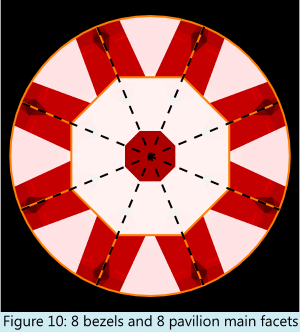 Similar to the creation of the hearts, also, every arrow is
formed by several facets. Exactly how many facets are needed to
form at least one complete arrow? Let's investigate the
formation of an arrow. In figure 10 the start state with 8
bezels and 8 pavilion main facets is shown, when looking
perpendicular through the table. Again the assumption is made
that the girdle is a perfectly round girdle. We start with
polishing the first pavilion half facet, ph1. The result of this
action is visualized in figure 11.Each pavilion half facet has
an impact on the arrow above and the arrow opposite to this.
Figure 12 shows the effect of polishing the next half, ph2. This
creates the biggest part of the arrow head and the rough shape
of the arrow shaft. In figure 13 and 14 the opposite halves, ph9
and ph10
are polished. The result of this action is a reshaped, smaller, arrow
shaft.
Finalizing the first arrow requires the polishing of the crown star facets. Figure 15 illustrates
the effect of the creation of the first star facet, Cs1. The star facets cut off the arrow point
from the shaft and start forming the star shaped inner pattern round the center of the diamond.
Similar to the creation of the hearts, also, every arrow is
formed by several facets. Exactly how many facets are needed to
form at least one complete arrow? Let's investigate the
formation of an arrow. In figure 10 the start state with 8
bezels and 8 pavilion main facets is shown, when looking
perpendicular through the table. Again the assumption is made
that the girdle is a perfectly round girdle. We start with
polishing the first pavilion half facet, ph1. The result of this
action is visualized in figure 11.Each pavilion half facet has
an impact on the arrow above and the arrow opposite to this.
Figure 12 shows the effect of polishing the next half, ph2. This
creates the biggest part of the arrow head and the rough shape
of the arrow shaft. In figure 13 and 14 the opposite halves, ph9
and ph10
are polished. The result of this action is a reshaped, smaller, arrow
shaft.
Finalizing the first arrow requires the polishing of the crown star facets. Figure 15 illustrates
the effect of the creation of the first star facet, Cs1. The star facets cut off the arrow point
from the shaft and start forming the star shaped inner pattern round the center of the diamond.
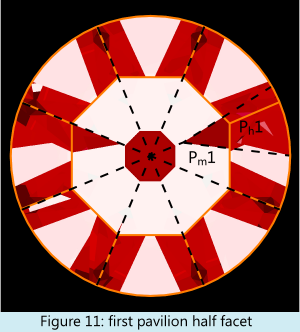
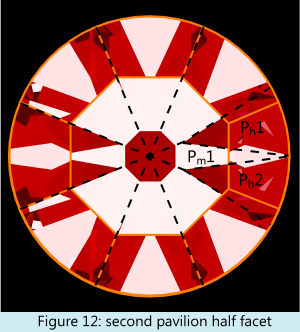
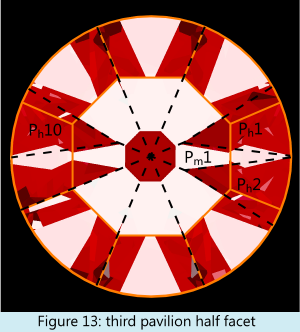
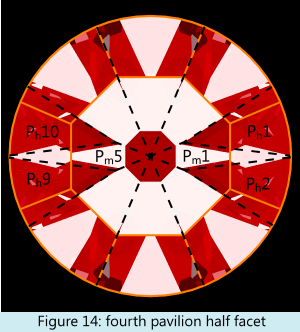
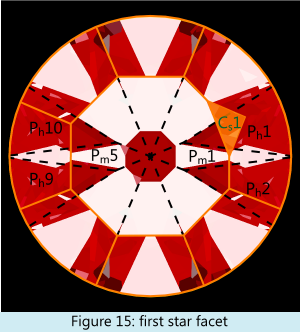
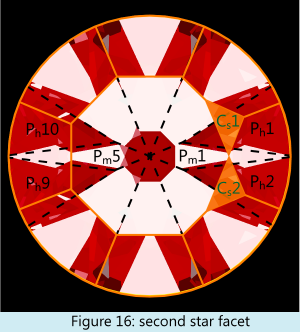
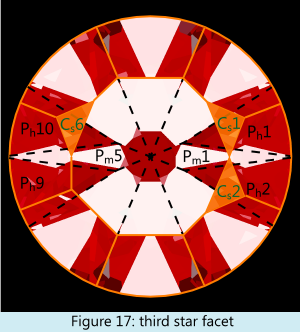
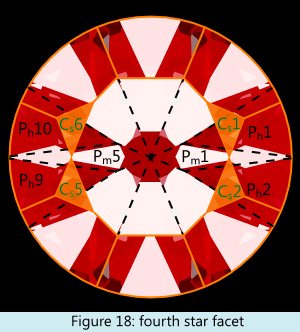
General Conclusion
Every H&A pattern is created by several facets. In descending order of importance, the most important facets are:
- The pavilion main facets
- The pavilion halve facets
- The table
- The crown main facets
- The star facets
The crown half facets only influence the surrounding circular band close to the girdle. The correct
proportions are discussed in a previous article: “Hearts and Arrows by HRD Antwerp - Relationship
with the cut parameters”. The next article will give more information on the influence of facet
position and orientation errors on the hearts and arrows patterns.
- The pavilion halve facets
- The table
- The crown main facets
- The star facets